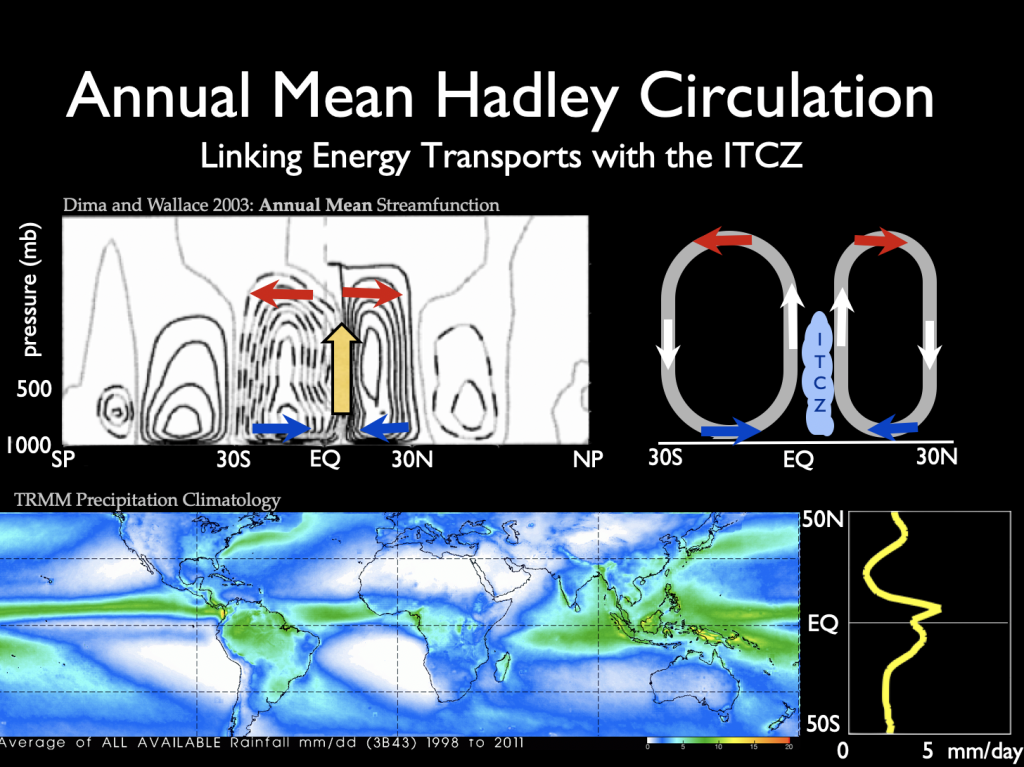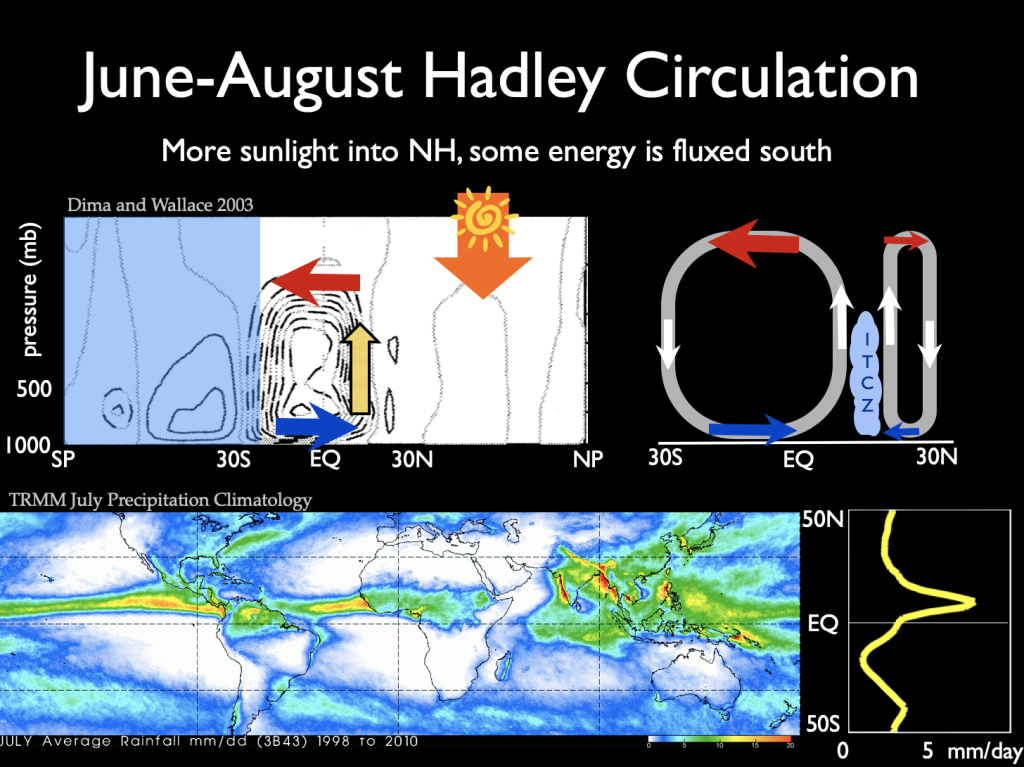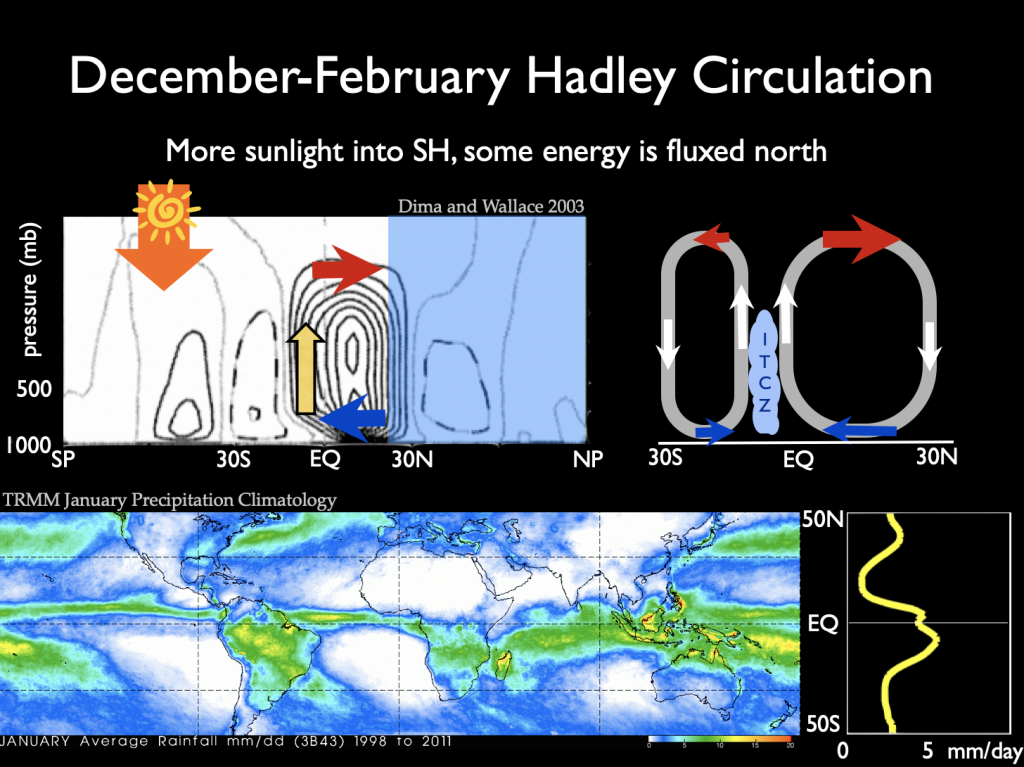13 Shifts of Rain
In our previous discussion about precipitation changes with global warming, we distinguished between thermodynamic and dynamic changes.
- Thermodynamic precipitation changes are due to increases in temperature, and the accompanying ability of warmer air to hold more moisture. Moisture increases over much of the world in response to temperature changes, meaning with a given amount of upward motion,
- Dynamical precipitation changes are due to changes in winds. This can take various forms, including poleward shifts of midlatitude storm tracks, changes in intensity of storms, and shifts in location or intensity of rising motion in the tropics.
In the tropics, we describe rainfall as occurring over the warmest ocean temperatures, where both rising motion and humidity are plentiful. In this model of precipitation, it is clear that any tropical process that affects the ocean temperatures, such as ocean dynamics or radiative feedbacks and forcings, can clearly change rain. But we live on a connected planet, in which even the high latitudes can affect tropical rainfall, and vice versa. Next, we’re going to explain how any process that heats one hemisphere more than the other results in a tropical rainfall shift towards the heating.
Consider first the seasonal cycle of tropical precipitation, to develop some intuition for how this process works. In the annual mean, two Hadley cells are visible, each transporting energy poleward and moisture equatorward. The center of the cells exists slightly in the Northern Hemisphere (NH), coincident with the annual mean inter-tropical convergence zone (ITCZ) location north of the equator.
During Northern Hemisphere (SH) summer, there is much more shortwave heating of the NH than of the Southern Hemisphere (SH). The tropical circulation responds by fluxing some of this energy across the equator towards the SH. This occurs via a cross-equatorial Hadley circulation, an expansion of the SH winter cell, which dwarfs the NH summer cell in these months. The cross-equatorial Hadley cell fluxes energy southward via its upper branch, from warm to cold. Moisture, on the other hand, is concentrated near the surface, so is fluxed by the lower branch of the Hadley cell, from SH to NH. Precipitation thus shifts northward within NH summer.
During SH summer (DJF), the opposite occurs. The NH winter cell expands greatly, fluxing energy from SH to NH, and moisture from NH to SH. In both seasons, energy is fluxed away from the warmed hemisphere, and moisture is fluxed towards warming. The ITCZ thus shifts toward heating, and away from cooling.
The ITCZ even responds to heating well away from the tropical regions. As part of her Ph.D. dissertation, Prof. Sarah Kang studied how much heating anomalies confined to the extratropics could shift the ITCZ. Placing a heat source in the high latitudes of one hemisphere, and a cooling source in the other (equal and opposite, so that changes in global averaged temperature would be minimal), she found that the ITCZ could shift completely across the tropics, from 17 N to 17 S, due to extratropical changes alone. The mechanism for this change is that eddies carry heat into the subtropics, essentially diffusing moist static energy, as described in prior chapters, and then the Hadley circulation takes over within the tropics, with the mechanism described above with the seasonal cycle. Crucial uncertainties appear due to the effects of atmospheric feedbacks, which can amplify or damp the applied heating anomalies.
Another important limiting aspect is the ocean circulation. Since the surface winds within the Hadley cell also drive upwelling patterns within the tropics, any Hadley cell shift is accompanied by a cross-equatorial ocean circulation which acts to damp the atmospheric change.
With these mechanisms and caveats in mind, let’s apply this to two different questions: why is the ITCZ in the Northern Hemisphere? And why did the ITCZ shift southward in the late 20th century?
Why the ITCZ is North of the Equator
Based on the arguments above, we can figure out why the ITCZ is north of the equator by examining what heats the NH atmosphere more. Let’s consider some suspects:
- Downward solar radiation at top of atmosphere is exactly symmetric between NH and SH in the annual mean. Although there is more sunlight incident during times in which the Earth is closest to the Sun (currently in SH summer), the Earth moves more quickly in its orbit around the Sun during those months. These two factors exactly cancel, leaving perfect symmetry in the annual mean.
- Net radiation is actually larger in the SH than the NH. This is largely due to two factors: first, the Sahara and Arabian deserts, which lose energy on average, due to their high albedo desert surfaces, and their lack of a greenhouse effects, because clouds and water vapor are both scarce. It is pretty amazing that the hottest places in the world actually have energy transport towards them, due to this fact about radiation! Second, the continent of Antarctica absorbs much more net radiation than the Arctic. Both the North Pole and the South Pole have high albedo, but since Antarctica is extremely high altitude, outgoing longwave radiation is very small there. This leads to more radiation leaving the Arctic than the Antarctic.
- The cause of the NH location of the ITCZ is therefore the only factor that is left: the cross-equatorial ocean circulation, which fluxes a large amount of energy from SH to NH within the Atlantic Ocean. The Atlantic Meridional Overturning Circulation (AMOC) is the cause of this. Sinking motion near Greenland flushes out cold water from the surface, resulting in a tugging of warmer waters toward the North Atlantic. This heat flux is more than sufficient to shift the ITCZ into the NH. We found that climate models with this ocean transport taken out have their ITCZ shifted entirely into the SH, as expected from the radiation argument in the previous point.
A Southward Rainfall Shift in the Late 20th Century
In the 1950s industrialization accelerated rapidly in higher-consuming countries across the world. This resulted in both an acceleration of carbon dioxide emissions, and emissions of sulfur dioxide. While the former caused an increase in radiative forcing, the latter caused a negative radiative forcing. Since aerosol emissions were primarily located in the NH, this imbalance of forcing led to a pause in warming in the NH during the 1960s and 1970s. The unshaded SH, on the other hand, continued to warm slowly and steadily.
Examined from the energetic framework described above, one might expect a southward shift of the ITCZ to go along with the cooling in the NH. Indeed, climate models show such a shift, although it occurs in different longitudinal locations, which is due in part to diverse El Niño responses across climate models (discussed in the next chapter). Since aerosols force tropical Atlantic temperatures directly to some extent, there is generally a larger southward shift over Africa. Such a shift was seen in the Sahel drought, in which less precipitation occurred from the 1950s-1980s, nearly completely drying up Lake Chad. As Clean Air Acts were imposed in the US and Europe in the 1990s, the NH has cleaned up. The precipitation in the Sahel has returned more towards its rainier state along with this.
The Future
With continued heat-trapping gas emissions and decreases in sulfur dioxide pollution (which are currently back to 1960s levels), the Earth is warming faster than ever now. How might the ITCZ respond? There are several competing factors here.
- First, the Arctic is warming faster than any other location on Earth. This fact on its own should shift the ITCZ northward, although there is some evidence that surface-trapped warming in the Arctic is less able to affect other latitudes than more well-mixed warming which occurs at other latitudes.
- The AMOC is decelerating, and projected to continue to decelerate, although model projections of this vary considerably.
- Patterns of feedbacks, which cause enhanced warming in some locations, and less warming in others, also vary substantially across models.
- Patterns of forcing, most importantly the expected continued cleanup of sulfate aerosol emissions, should shift rainfall northward.
- Other ocean circulation changes are another wildcard, which we will discuss in the ocean section soon.




